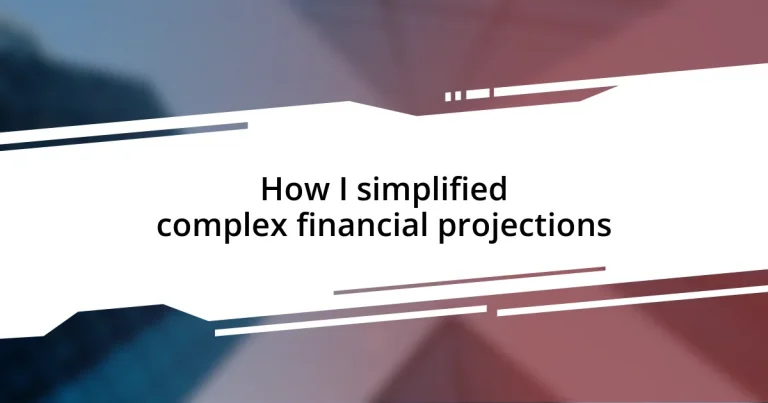Key takeaways:
- Financial projections are educated guesses about future performance, grounded in historical data and market trends.
- Identifying key financial metrics, such as gross profit margin and ROI, is crucial for insightful analysis and strategic discussions.
- Breaking down assumptions into categories improves clarity and aligns expectations, fostering trust with stakeholders.
- Utilizing visual tools like charts and infographics enhances data comprehension, making complex information more engaging and accessible.

Understanding Financial Projections
When I first encountered financial projections, I felt like I was diving into a foreign language. Understanding the terminology—like revenue forecasts and expense estimations—was daunting at first. But as I delved deeper, I realized that these projections are simply educated guesses about the future, grounded in historical data and market trends.
I remember grappling with numbers that seemed to tell an unpredictable story. It struck me that financial projections are not just about crunching the numbers; they are about anticipating future opportunities and risks. Have you ever caught yourself wondering how businesses plan for the unexpected? That’s the magic of projections—they help illuminate potential paths forward, enabling informed decision-making.
As I learned more about creating financial projections, I discovered the importance of being realistic yet optimistic. It’s a delicate balance: while we aim high, we must also anchor our estimates in reality. This approach transformed my perspective, making me more confident in using these tools to strategize effectively, turning what once felt intimidating into an empowering experience.

Identifying Key Financial Metrics
Identifying the right financial metrics can feel like solving a puzzle. Early in my journey, I focused excessively on numerous figures, quickly realizing not every number holds equal significance. By honing in on vital metrics like gross profit margin and operating cash flow, I could glean clear insights about a company’s health and potential growth. It’s fascinating how these key indicators create a more focused narrative about financial performance.
In my experience, understanding these metrics isn’t just valuable for analysis; it also shapes strategic conversations. When I presented financial forecasts to my team using key metrics, the discussions became more dynamic and informed. Instead of getting lost in the weeds, we centered our efforts on actionable insights that could drive our goals forward. As I often say, knowing which metrics matter can transform confusion into clarity.
Lastly, I’ve found that aligning metrics with specific business goals streamlines decision-making. For instance, when I used return on investment (ROI) to evaluate our marketing efforts, it illuminated which strategies were effective and which needed rethinking. Choosing the right metrics doesn’t just aid in projecting; it builds a clear connection between actions and outcomes, fostering a culture of accountability and growth.
| Financial Metric | Significance |
|---|---|
| Gross Profit Margin | Indicates the percentage of revenue that exceeds the cost of goods sold, reflecting pricing strategy and production efficiency. |
| Operating Cash Flow | Measures the cash generated from operations, providing insight into the cash flow situation of the business and its ability to maintain operations. |
| Return on Investment (ROI) | Evaluates the profitability of an investment to determine its effectiveness and guide future investments. |

Breaking Down Assumptions Clearly
When I started breaking down my financial assumptions, I learned that clarity is key. I used to lump all my assumptions together, which caused confusion and misaligned expectations. One day, sitting at my desk with simply a notepad, I decided to separate my assumptions into categories like market growth, customer acquisition, and operational costs. It was a game changer, as I was able to pinpoint weaknesses and strengths more easily in my projections.
Here’s how I approached this process:
- Categorization: I divided assumptions into clear sections, making it easier to identify impacts in specific areas.
- Realism: I ensured each assumption was based on robust data and evidence. Doing this built my confidence.
- Consultation: I reached out to colleagues for their opinions on my assumptions, which provided diverse perspectives that enriched my analysis.
The act of breaking down assumptions also allowed me to convey my thought process more effectively to stakeholders. I discovered how vital it was to articulate my reasoning behind each financial guess. By doing so, I created trust, as they could see the rationale guiding my projections. It’s fascinating how this simple shift in approach made discussions more productive and engaging.

Simplifying Data Interpretation Techniques
One technique I’ve found invaluable is visual data representation. Early on, I used to present data solely in tabular formats, which felt monotonous and overwhelming. I decided to use charts and graphs instead, transforming dense data into visually engaging formats. Watching stakeholders react positively to a simple pie chart showing revenue breakdowns was enlightening. Have you ever seen how a visual can turn numbers into a story? It’s a bridge to understanding that often makes complex information more digestible.
Another approach that made a significant difference was storytelling with data. I learned that weaving a narrative around the figures not only held attention but also enhanced comprehension. For instance, when I illustrated a quarterly decline in sales, I didn’t just throw out figures; I connected it to market trends and customer feedback. It made the data relatable. Have you ever struggled to remember a statistic but recalled a story around it? This emotional connection often makes the information stick!
I also implemented a feedback loop to refine my data presentation. After each financial review, I sought input from my team on what worked and what didn’t. This practice fostered collaboration and allowed us to streamline the insights further. It’s rewarding to see how collective insights can enhance our data interpretation techniques! Have you tried involving your audience in your data discussions? Engaging others often opens doors to fresh perspectives we might not consider alone.

Using Visual Tools for Clarity
Visual tools are a fantastic way to transform abstract numbers into something that speaks to people. I remember the first time I employed a heat map to highlight areas of potential growth versus risk. My colleagues were captivated as they could instantly see where to focus our efforts. Isn’t it interesting how a splash of color can breathe life into what once seemed like dull statistics?
Another game changer for me was using infographics to summarize complex projections. I crafted a flowchart that mapped out our financial journey over the next year, from revenue streams to expenses. The reaction was amazing—everyone could grasp the big picture at a glance. How often do you find yourself lost in a sea of data? Visual representations really help anchor understanding, turning intimidation into clarity.
I also embraced interactive dashboards. These allowed my team to drill down into the specifics without losing sight of the overall strategy. I recall a meeting where we explored various scenarios using live data, and the energy in the room was palpable. Have you ever felt the buzz of creativity that comes from engaging with numbers in real-time? It truly fosters a sense of collaboration and innovation that static reports simply can’t match.

Practical Steps for Creating Projections
Creating accurate financial projections doesn’t have to be daunting. One effective method I’ve found is breaking down the projections into smaller, manageable components. For example, when I first undertook a complicated five-year financial forecast, I divided it by quarters. This approach allowed me to focus intensely on the short term before moving to the long term. Have you ever felt overwhelmed just looking at a massive dataset? It’s much more approachable when you simplify it into smaller bites.
A pivotal step in my process has been using historical data as a foundation for projections. I remember sifting through past performance on sales and expenses, which revealed trends I’d missed before. By employing this data, I felt much more confident in my projections. How often do we overlook our past when crafting future plans? Our history can be an invaluable teacher if we choose to learn from it.
Additionally, engaging with stakeholders during the projection process has proven essential. Inviting input allows for diverse perspectives that can refine your forecasts significantly. I remember setting up a workshop where each department contributed their insights, and the resulting discussions opened my eyes to previously unconsidered variables. Isn’t it fascinating how collaboration can illuminate pathways that we might not see on our own? This shared process not only enhances accuracy but also builds collective ownership of the financial goals.

Overcoming Common Projection Challenges
I often faced the challenge of dealing with uncertainty in financial projections, but I’ve learned that embracing it is part of the journey. For instance, once I encountered a volatility spike that threw my numbers into chaos. I realized that conducting sensitivity analyses—testing how different variables might impact outcomes—gave me a clearer sense of worst-case and best-case scenarios. Have you ever felt the weight of uncertainty lift just by figuring out what’s at stake?
Another hurdle was ensuring that the assumptions behind my projections were sound. I recall a time when I made overly optimistic revenue forecasts based on market trends without deep analysis. After receiving feedback from my team regarding potential pitfalls I had overlooked, I adjusted my assumptions based on more rigorous research. How often do we rush into projections without pausing to challenge our own assumptions? Taking that extra time to validate was eye-opening for me and made my financial forecasts much more reliable.
Lastly, I found that staying flexible throughout the projection process is vital. I once clung to a set forecast, even when changing market conditions suggested otherwise. Adapting my projections based on real-time feedback allowed my team to pivot swiftly and capitalize on new opportunities. Isn’t it amazing how a willingness to adjust course can lead to unexpected successes? Embracing change, rather than resisting it, ensures that our financial strategies remain relevant and actionable.














